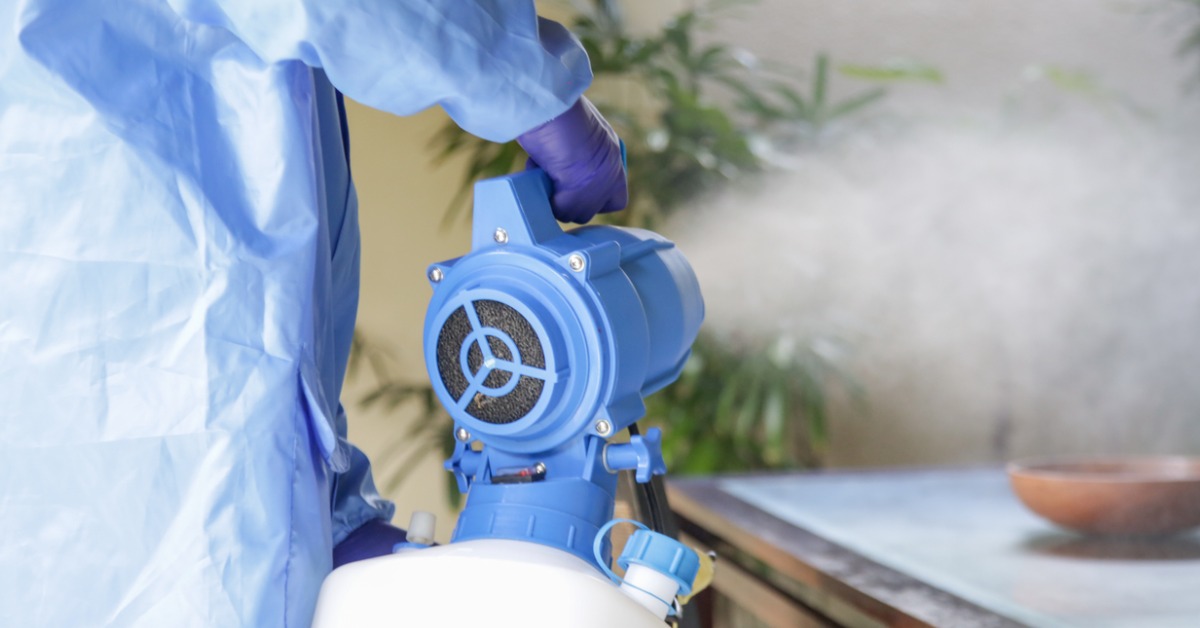
Disinfectant fogging is a chemical application method where very fine droplets of disinfectant are sprayed throughout a room in a fog. The disinfectant has to reach a certain concentration level for a specified period to be effective. Although disinfectant fogging isn’t a commonly used method for disinfecting, in a small number of industries it’s a vital way to ensure the area is sufficiently disinfected.
What is Fogging?
Disinfectant fogging is where very fine droplets of disinfectant are sprayed throughout a room. The fog, mist or vapour disinfectant must reach a particular concentration for a prescribed period to be effective. Only approved fog machine solutions are suitable for fogging as aerosolized micro-particles of hazardous chemicals can be absorbed by the human body much faster and in greater quantities than larger particles.
Where is Fogging Used?
Fogging is used by a few industries that benefit from the dry mist technique for disinfecting whole rooms and the air. Built-in sprayers are often used for large areas over 200m³ and mobile units used in smaller areas. The disinfectant is usually dispersed for a minimum of 15-30 minutes. It may take an hour for all the droplets to settle out of the air and be safe for workers to return to the space.
Food Industry
In Australia, fogging is most used in the food production industry. During manufacture, food can be exposed to contamination from surfaces and the air causing the food to spoil or become contaminated. Cleaning and disinfection of surfaces reduces the risk of contamination, but it doesn’t eliminate all environmental microorganisms completely. High-risk food production lines may use fogging to reach surfaces that are difficult to disinfect such as ceilings, walls and equipment as well as the air. Fogging may reduce food wastage and increase profitability. Only fogging products approved for food contact surfaces may be used.
Healthcare Industry
Some pharmaceutical production companies also use fogging to ensure the air, equipment and hard to reach surfaces are disinfected. Overseas fogging has been used to disinfect ambulances, but its use isn’t recommended due to the health risks of paramedics who can breath in the tiny particles causing work-related asthma or skin irritations.
Fogging and COVID-19
Some of the earliest images we saw of the pandemic were vehicles spreading disinfectant throughout the streets using a fogging method. Fogging is not required or recommended by the Australian Government Department of Health for routine cleaning against COVID-19. Instead, a disinfectant should be used on a clean surface. The World Health Organisation has also advised against using fogging for disinfecting footpaths and outdoor areas as spraying disinfectants even outdoors can cause eye, skin and lung irritations.
Products Suitable for Use in Fogging Machines
Very few disinfectant products are suitable for use in fogging machines. Alcohol-based solutions can lead to a fire or explosion if an ignition source is present. Chlorine products are highly irritating to workers.
Helix Solutions supplies Sanosil as a suitable product for use in fogging machines. With active ingredients of hydrogen peroxide and silver, Sanosil is used to treat water to make it safe to drink. Therefore, Sanosil is completely safe for use in food production facilities. Hydrogen peroxide’s chemical formula of H2O2 means that once it breaks down the by-products are oxygen and water.
Sometimes organisations consider using fogging disinfectants when they shouldn’t because of the risk to workers. The business may have surfaces that need disinfecting after cleaning. The time and high cost involved in cleaning and disinfecting surfaces makes organisations look for faster, cheaper alternatives like fogging. But a safer alternative is to cut the two or three-step process of cleaning and disinfecting into one. Chlor-Clean is a two-in-one, hospital grade cleaner and disinfectant. Cleaning staff dissolve a tablet in one litre of water and use the solution to spray on surfaces to clean and disinfect at the same time.
More Information
If you’d like to know about how Sanosil or Chlor-Clean can work to disinfect your organisation, call us on 1300 29 32 32 or contact us online.